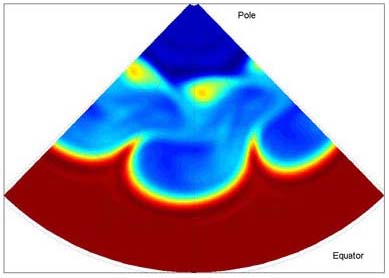Columbia Team Shows How Stratospheric Conditions Affect Weather

The above map shows a snapshot of surface temperature in the Northern Hemisphere, with weather systems moving poleward. In the paper, the authors demonstrate that this process is influenced by the presence of a stratospheric jet.
New research may improve long-term forecasting skills
The authors, left to right: Andrew Charlton, postdoctoral student; Matthew Wittman, graduate student and principal author; and Lorenzo Polvani, Professor of Applied Physics and Applied Mathematics & Earth and Environmental Sciences and Director of the IGERT Joint Program in Applied Mathematics and Earth and Environmental Sciences.
by Jennifer Freeman
Three members of Columbia’s Department of Applied Physics and Applied Mathematics have used a simple climate model to demonstrate how the weather systems and storms we experience may be influenced by disturbances in the Earth’s stratosphere, the upper layer of atmosphere between 10 and 30 miles high. This Earth Institute research was recently highlighted by the American Geophysical Union, following recent publication in the journal Geophysical Research Letters. “Our research shows that changes to the strength of winds in the stratosphere cause changes to tropospheric weather systems” explained lead-author Matthew Wittman.
Understanding how the stratosphere affects the troposphere, the lowermost layer of the atmosphere where weather occurs, is important to improving seasonal weather forecasts and predicting the effect of ozone depletion and global warming on our climate. “The stratosphere has a longer ‘memory’ than the troposphere,” adds co-author Andrew Charlton. “If you want to make forecasts on a time scale longer than several days, it is useful to understand the mechanisms linking places with longer memories, such as the stratosphere and the oceans to the troposphere.”
Each winter a westerly jet — called the Polar Night Jet — forms in the stratosphere. Winds in this jet circulate around the pole at speeds of up to 100 miles per hour. The strength of this jet changes as part of normal atmospheric variability, and possibly also in response to climate change. In their new research, the authors show that the presence of stronger westerly jets in the stratosphere causes tropospheric weather systems to track further towards the pole.
Averaging the changes to the paths of weather systems, the research team showed, produces a pattern of changes similar in structure to the Arctic Oscillation, the dominant pattern of climate variability in the Northern Hemisphere that describes how temperatures across the whole hemisphere vary together.
The research is part of the team’s ongoing efforts to understand the interaction of the stratosphere and troposphere and improve the representation of this interaction in climate models. The Columbia co-authors — Matthew Wittman, Lorenzo Polvani, Richard Scott and Andrew Charlton — are affiliated with the climate research group at the Earth Institute at Columbia.
The Earth Institute at Columbia University is the world’s leading academic center for the integrated study of Earth, its environment and society. The Earth Institute builds upon excellence in the core disciplines — earth sciences, biological sciences, engineering sciences, social sciences and health sciences — and stresses cross-disciplinary approaches to complex problems. Through research, training and global partnerships, it mobilizes science and technology to advance sustainable development, while placing special emphasis on the needs of the world’s poor. (Jennifer Freeman)
Media Contact
All latest news from the category: Earth Sciences
Earth Sciences (also referred to as Geosciences), which deals with basic issues surrounding our planet, plays a vital role in the area of energy and raw materials supply.
Earth Sciences comprises subjects such as geology, geography, geological informatics, paleontology, mineralogy, petrography, crystallography, geophysics, geodesy, glaciology, cartography, photogrammetry, meteorology and seismology, early-warning systems, earthquake research and polar research.
Newest articles

“Nanostitches” enable lighter and tougher composite materials
In research that may lead to next-generation airplanes and spacecraft, MIT engineers used carbon nanotubes to prevent cracking in multilayered composites. To save on fuel and reduce aircraft emissions, engineers…

Trash to treasure
Researchers turn metal waste into catalyst for hydrogen. Scientists have found a way to transform metal waste into a highly efficient catalyst to make hydrogen from water, a discovery that…

Real-time detection of infectious disease viruses
… by searching for molecular fingerprinting. A research team consisting of Professor Kyoung-Duck Park and Taeyoung Moon and Huitae Joo, PhD candidates, from the Department of Physics at Pohang University…




















